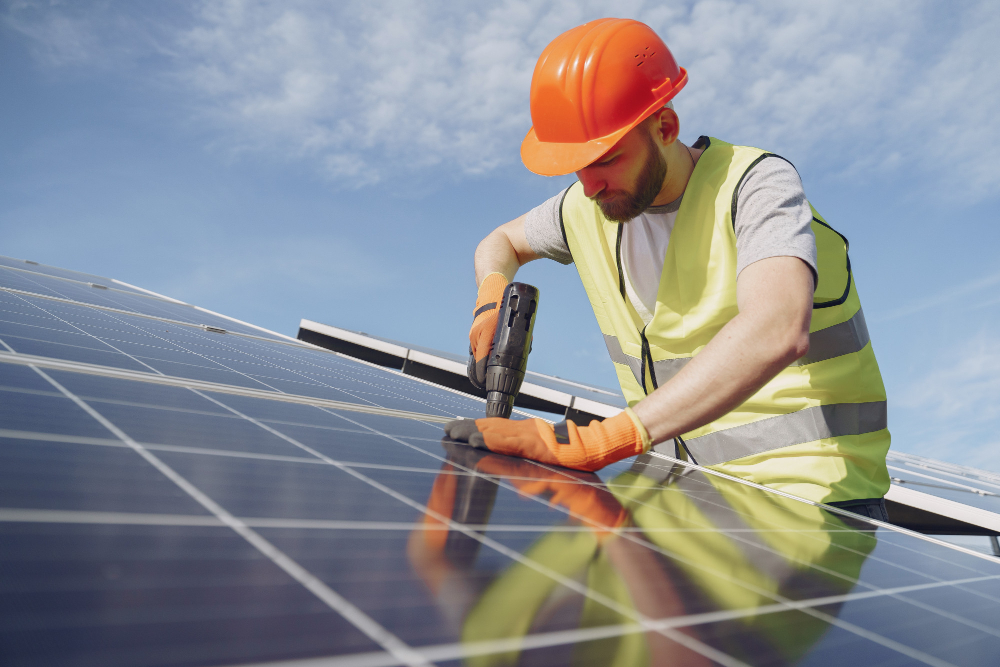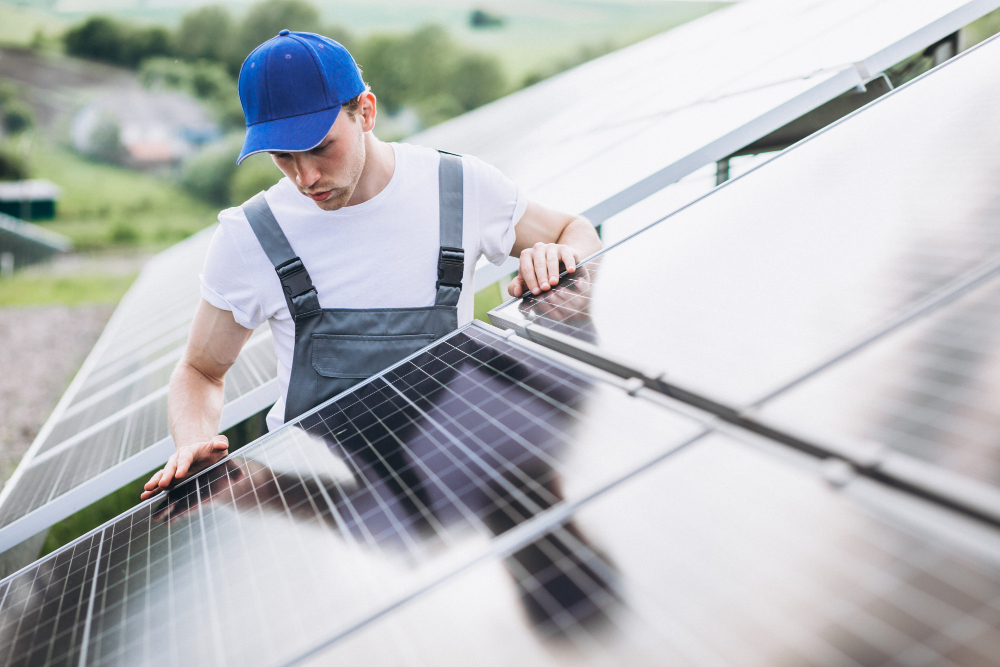Table of Contents
ToggleSolar energy is a source of renewable energy that is easy to harness. The solar panels can also last up to thirty years. Nonetheless, a solar system requires regular monitoring to ensure maximum efficiency for the highest energy output. Sometimes, solar panel repair becomes necessary due to wear and tear to push for continuous efficient generation of sustainable energy.
The primary components of a solar panel system
Several key components make up a solar panel system. They are:
- Solar panel – the most conspicuous part of the system. The panel’s photovoltaic cells absorb sunlight to turn into electricity.
- Inverter – a converter that converts the electricity (Direct Current) into Alternating Current (AC) to power the property.
- Battery – stores excess electricity for use when the solar panels are not generating sufficient electricity due to lack of sunlight.
- Charge controller – regulates voltage and current from solar panels to avoid battery overcharging.
- Cables – wiring that connects components.
- Mount – racks and hardware that secure solar panels in preferred position and angle.
- Electrical panel – a breaker box that distributes solar power throughout the property.
- Grid connector – to channel excess electricity to the national power grid or to draw electricity from it when solar energy is low.
Importance of regular maintenance for the longevity of solar panels
The longevity of solar panels does not solely mean the number of years the panels can last. It also means the duration that they can generate solar energy at the most efficient rate.
Regular cleaning is the most basic care owners can do to keep solar panels in good working condition. Additionally, periodic inspection helps to identify and address issues at the first instance. Repair solar panels, when necessary, to extend their lifespan.
Follow the recommended solar panel maintenance schedule by the manufacturer. Adhering to it can protect your warranty coverage. Besides avoiding potential disputes, a maintenance program safeguards your solar investment to generate sustainable energy production effectively.
Read: Solar panel maintenance


Common solar panel problems
While the initial setup cost may be high, solar panels are low maintenance. However, as they are placed outdoors and exposed to the elements, several common solar panel problems exist.
Decreased energy output
Age-related issues are the most common degradation concerns with solar panels. In addition to delamination, seals and adhesives harden and weaken over time. It causes water to infiltrate the solar panels, reducing efficiency and potential damage to internal components.
Apart from age, the two most cited factors are the accumulation of dirt or airborne impurities, and tree shading.
Solutions:
- Clean the dirt with solar panel cleaning solution and water on a squeegee or cloth.
- Check for overhanging tree branches that might block sunlight and trim them.
Physical damage to panels
Thunderstorms, lightning strikes, hail, and other severe weather conditions that cause falling debris can damage solar panels. The severity can range from micro-cracks to a major breakage, impacting system efficiency.
Solution:
- Contact a broken solar panel repair company to assess the damages. Review if your solar system warranty covers damage caused by weather impact.
Inverter issues
Inverters are like bridges between the photovoltaic system and the power grid. Besides component age, heat stress is a huge factor that could cause inverters to fail.
Additionally, similar to any electronic device, an inverter might suffer from firmware issues.
Solution:
- Contact a solar panel repairer nearby for thorough checks if irregularities are spotted.
- Regular updates to the latest firmware version will avert issues that could include a system-wide breakdown.
Wiring and connection problems
Loose connections or frayed wiring can result in power loss or, worse, cause a fire hazard.
Solution:
- Engage in a solar panel repair service as soon as possible.
Can solar panel glass be repaired?
Most of the time, the damaged panel can be repaired, depending on severity. However, there are several opinions on the repair of solar panels.
- Replacement glass is often less durable than the original panel.
- The cost of repair of solar panel glass is higher than replacement.
- It is safer to replace than repair.
Slight damages like minor scratches or scuffs on the glass do not affect the performance of solar panels. It also does not pose a danger to people or property.
If complex repairs or replacements are needed, always engage professional services. Do not stinge on the solar panel repair cost.
DIY repair techniques
While you can handle minor repairs yourself, it is crucial to take additional safety measures. Here are a few simple steps to maintain your solar system in tip-top condition.


Cleaning solar panels
Safety is paramount when touching the solar system.
- Clean during the cooler hours of the day.
- Turn off the solar system first before starting the process.
- Sweep away leaves, twigs, bird droppings, and other debris.
- Dip the squeegee into a cleaning solution and scrub the panels gently.
- Hose the panels with clean water to wash away soap residue.
- Dry the panels using a clean towel.
- Inspect for damage while cleaning the panels.
Repairing minor physical damage (broken solar panel repair)
Minor damages to solar panels can often be DIY repaired. While the process may vary depending on the specifics, here are the general steps to learn how to repair solar panels.
- Clean the area of the damaged spot.
- Sand down rough edges to smoothen the surface.
- Apply sealant around the perimeter of the damaged area.
- Paint over the sealant to cover it.
Troubleshooting inverter issues
Following standard safety guidelines for solar panels, there are a few steps to troubleshoot inverters.
- Decipher error codes or error light signals – what does the manual say?
- Power check – is the power outage just at the inverter or the rest of the property?
- Circuit breaker – is the switch still turned on?
- Reboot the system by switching it off and on.
If the issue persists, engage a professional solar repair service company.
Fixing wiring and connections
Always take extra precautionary measures when handling electrical wiring components. It is vital to disconnect the solar system first and foremost. If unsure, hire a certified solar system repairer.
Check that wires have no visible damage or are suffering from wear and tear. These connections should also be tightly secure to prevent energy loss.
Read more at: Solar Panel Wiring Guide
When to call a professional solar panel technician?
Irrespective of the size of the issue, if you lack confidence in handling it yourself, it is advisable to call in the professionals. Generally, they can address the following tasks related to solar panel systems, providing homeowners with peace of mind.
- Installation
- Maintenance
- Repairs
- System upgrade
- Emergencies
Solar panel repair cost
Maintaining and repairing solar panels is part and parcel of owning a solar system. Calculating the repair costs is a task that many owners have to face one day.
The cost hinges on the scope and extent of work required, repairing or replacing, and the quality of replacement parts.
Also, labor charges vary from one repair company to another. The location site could also be a determining factor in the cost of labor and repairs.
Always insist on a price quotation in black and white before proceeding with the work. Request a quote from a few nearby solar panel repairers to make an informed decision.


Upgrading your solar panel system
While solar panels can continue to generate energy for decades, there may be instances when an upgrade of the system is required. These include:
- Increase in energy needs – more occupants, new appliances, or the need to charge an electric vehicle.
- Ending of feed-in tariffs (FITs) – if your incentive is about to end or has ended, an upgraded system will continue to keep electricity bills low.
- Aged system – an upgrade will improve efficiency, especially with the adoption of newer technology.
From the early days of solar energy adoption, solar systems have seen a significant leap in technological advancement. They are more efficient and durable. Among the newer solar products in the market are:
- High-Efficiency Solar Cells – improved from silicon-based solar cells at 15-20% to over 25% efficiency rate
- Perovskite Solar Cells – alternative to silicon-based cells, with the ability to capture blue light
- Bifacial Solar Panels – dual-sided panels that absorb light from both sides
- Flexible and Transparent Solar Panels – can be integrated into different surfaces
- Solar Panel Coatings and Tracking Systems – improved efficiency and lifespan
Recycling solar panels
When replacing or upgrading solar panels, ensure proper recycling of discarded ones. The solar recycling process requires a few steps to minimize environmental impact. It also should comply with government regulations.
- Send solar panels to a specialized recycling facility.
- Disassemble panels to separate glass, aluminum frames, and silicon solar cells.
- Dispose of non-recyclable materials according to environmental regulations.
- Reuse or repurpose salvageable components.
Conclusion
The decision to embrace sustainable living with renewable energy is not a one-off action but a continuous commitment to a greener lifestyle.
This long-term pledge to reduce the carbon footprint goes beyond reducing electricity bills or achieving energy independence.
Whether making significant decisions like installing a solar system or opting for eco-friendly choices, embracing a green lifestyle contributes to leaving a legacy of a cleaner world.





